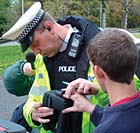U.K. Police Attracted to Mobile Electronic Fingerprinting

U.K. police use a mobile fingerprinting device, which can capture and then send biometrics data to a central database for checking.
The U.K.’s Police Information Technology Organization (PITO) will help speed up the process of establishing a person’s identity thanks to a pilot program called the Lantern Project, using a database search capability for new mobile fingerprinting technology.
The search capability developed by Northrup Grumman for the electronic mobile fingerprinting devices will enable the U.K. police to capture an individual’s fingerprint details in an operational environment for the first time and allow real-time searching of the U.K.’s national fingerprint database on the national identification system, known as IDENT1. That system allows routine identification of suspected criminals throughout the U.K. mainland with a unified collection of finger and palm prints as part of an integrated computer system designed to link more than 50 police forces and agencies in the U.K.
“The electronic mobile fingerprinting capability will accelerate the identification process of individuals during roadside stops, therefore decreasing the time police officers spend at their stations,” said Hugh Taylor, vice president of Northrop Grumman Information Technology sector. “This process improvement will allow police officers to spend more time on the front line, focusing on their public safety mission and making informed decisions.”
The Lantern electronic mobile fingerprinting device sends a scan of both index fingers of the subject to the central fingerprint database using encrypted wireless transmissions. A real-time search against the IDENT1 national fingerprint collection of 6.6 million prints is then conducted. Any possible matches are identified and returned to a police officer in a target time of less than five minutes.
The Lantern pilot project will aid the development of a national U.K solution for use by all police forces by demonstrating how it performs in an operational environment. Ten U.K. police forces are participating in the Lantern pilot project. The pilot is scheduled for completion in December 2007.
Looking for a reprint of this article?
From high-res PDFs to custom plaques, order your copy today!






